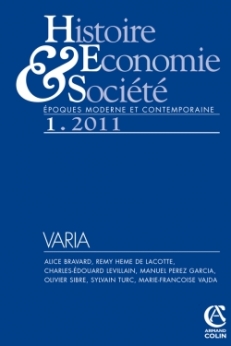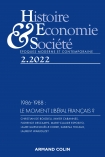
Histoire, économie & société (1/2011)
Pour acheter ce numéro, contactez-nous
Recevez les numéros de l'année en cours et accédez à l'intégralité des articles en ligne.
Dans un ouvrage de référence qui paraissait il y a plus de trente ans, Maurice Agulhon démontrait que l’embourgeoisement de la société française sous la Monarchie de Juillet avait entraîné le déclin des modes de sociabilité aristocratique, tels que les salons, et l’émergence de nouvelles pratiques issues d’une culture roturière, libérale et égalitaire, comme celle des cercles, qui se multiplièrent et se diversifièrent sur le territoire après 1830. Sans remettre en cause la validité de cette évolution propre à la première moitié du siècle, nous en expliquerons les limites, en nous appuyant sur un important fonds documentaire portant sur l’histoire des grands cercles de Paris entre la fin du XIXe et le début du XXe siècles. En effet, pendant cette période, la fréquentation de certains cercles de la capitale semble davantage constituer un habitus distinctif, réservé à une élite prestigieuse, restreinte par un critère de naissance, qu’un loisir bourgeois destiné à satisfaire la curiosité de notabilités professionnalisées. En réalité, le cercle apparaît comme l’un des hauts lieux d’une sociabilité proprement aristocratique, qui, loin de décliner, connaît un véritable renouveau dans la société française jusque dans l’entre-deux guerres.
In a reference work published more than thirty years ago, Maurice Agulhon showed that the fact that French society became more bourgeois under the July Monarchy had led to the decline of the modes of aristocratic sociability such as the salons and to the emergence of new practices which found their origin in a common, liberal, and egalitarian culture like that of the sociability circles which grew in number and became more diverse in the country after 1830. Without putting into question the relevance of this evolution peculiar to the first half of the century, I will try to explain its limits, by relying on an important collection of documents focusing on the history of the high society sociability circles of Paris between the end of the 19th and the beginning of the 20th century. Indeed, during that period, spending time in certain sociability circles of the French capital seems to have been a distinctive habitus enjoyed solely by a prestigious elite, and restricted by a birth criterion rather than just a bourgeois leisure activity meant to satisfy the curiosity of the professionalized notables. In fact, the sociability circles appear to have been one of the major centers of a peculiarly aristocratic sociability which far from declining, enjoyed a renewed interest in French society until the inter war.

